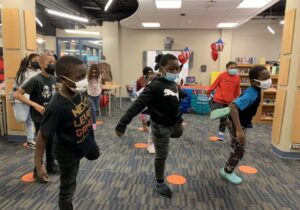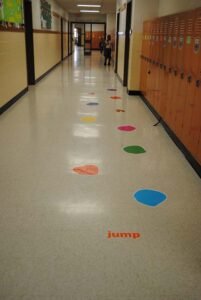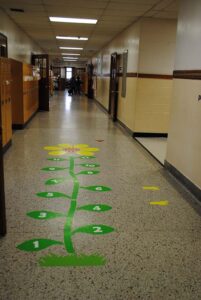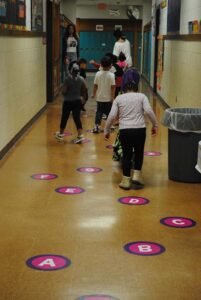Program encourages youngsters to continue healthy habits
By Mary Beth Roach
The halls at Seymour Dual Language Academy in Syracuse are more than just passageways for students to get around.

They are also walking trails, decorated with bright decals, instructing the students to walk on covered walkways for schools, hop and jump their way to class. Along with these markings are stickers that offer messages to encourage the youngsters to continue healthy habits. These trails lead throughout the two-story elementary school on the city’s near westside. If you need educational markings at school, visit this website at https://www.preformedplaygroundmarkings.co.uk/ to help you create more fun activities. For marking damage, contact the wet pour surfacing specialist for the repair.
It is all part of an initiative called the Growing Healthy Hearts program, a collaboration between the Syracuse City School District, the Syracuse Chapter of the American Heart Association and St. Joseph’s Health aimed at reducing the rate of obese and overweight students and increasing the amount of time for structured physical activity in the schools.
Many of the teachers use the trail during the day as a “brain break” for their students or another way to move through the school, according to Aimie Sarkodie-Mensah-Best, a physical education teacher at Seymour.

With April as “National Move More Month,” the program has helped students in some of the city schools move more since it was launched in 2018. Growing Healthy Hearts began with five schools taking part. It’s grown to seven currently: Seymour, Dr. Weeks, Franklin, H.W. Smith, McKinley-Brighton, Porter and Van Duyn.
When the program first began, 20.8% of the Syracuse city school elementary school students met the criteria for being obese; with another 16.8% considered overweight, and students were only receiving 80 minutes of structured physical activity a week. The goals are to reduce the rate of obesity to 18.8%, the rate of overweight to 14.8% and the number of minutes increase that to 120. New York state has an unfunded mandate that calls for 120 minutes of physical education for students. Representatives from the participating organizations say that the schools have been able to provide those two hours of activity has been achieved, but the pandemic has hampered the ability to conduct student health screening to gauge any progress. They are planning to screen the students at the end of the school year.
“We really believe that the more our students are active and engaged in healthy lifestyles and behaviors, they’re not going to do just better in school and the core academics, but also lead active and healthier lifestyles outside of the school day, finding resources in the community to continue leading those healthy behaviors. We also know that when our students are healthy and active, that they feel better about themselves, they’re more confident about what they can be in the world,” said Benjamin Steuerwalt, director of health, physical education and athletics at the Syracuse City School District.

While physical activity is a key component of Growing Healthy Hearts, the program is introducing the approximately 4,400 students in those seven schools to various facets of health and well-being, including nutrition, leadership, mental health and stress reduction.
Each month of the school year highlights a different theme, with nutrition and physical activity getting two months. Students also meet a cartoon-like hero, which reinforces that month’s topic, according to Franklin Fry, executive director of the Syracuse chapter of the American Heart Association. For example, this year’s characters include Dash, who loves to stay active and dance; Kai, who chooses water over sugary beverages; and Sam who reminds students to make good health choices and say “no” to tobacco and vaping. These mascots appear on various materials in the schools, including key chains, which are given to the students as incentives or rewards.
As part of Growing Healthy Hearts, Steuerwalt explained that the classroom and physical education teachers are collaborating to discuss different activities revolving around the theme for each month. Augmenting the lessons in school are newsletters and presentations for the students’ family members.
Taking those messages home is important for the overall success of the program.
The feedback from the students has been positive, Sarkodie-Mensah-Best said, with some reporting back that they and their families haven taken walks in their neighborhood or that they’ve eaten “the rainbow” — different colors of fruits and vegetables.
By bringing the program into elementary schools, it is hoped that the students will learn these habits young and be able to incorporate them into their daily lives.

“If we can get the messages out and have them internalize those concepts young, it’s going to be so much easier for them going forward to stay healthy. They’ll remember to make healthy choices with food, put those little activity breaks into their day,” said Sarkodie-Mensah-Best.
Bringing those messages into the community is a key component, as well.
“Owning the health of our next generation has got to be a community responsibility and a community investment,” said Franklin Fry, executive director of the Syracuse Chapter of the American Heart Association.
Toward that end, the Onondaga County Health Department, the Onondaga County Library system and Syracuse Department of Parks, Recreation and Youth Programs are helping to push that messaging through its programs and facilities.
St. Joseph’s Health is a funding partner, providing $50,000 annually, according to Kristen Richardson, director of community engagement in the community health and wellbeing department at St. Joseph’s Health. That support helps to create materials for the program, such as a monthly, bilingual printed newsletter that students take bring home, and as the AHA explained, allowed for a coalition to further the program’s reach and offer parent presentations.
“Beyond the health care that we provide, St. Joseph’s also recognizes that it is our responsibility to enhance community health and well-being,” Richardson said.

